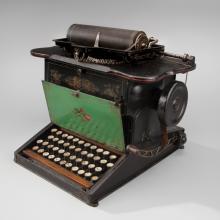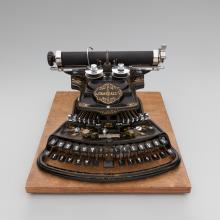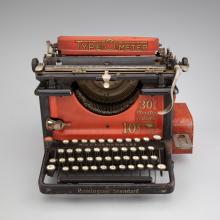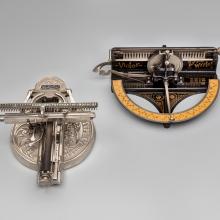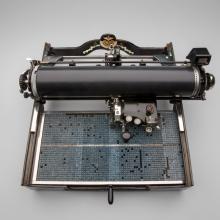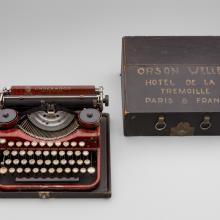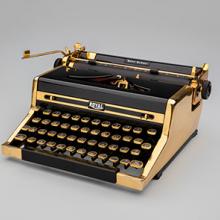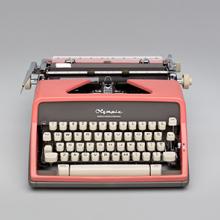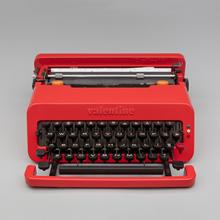Terminal 2
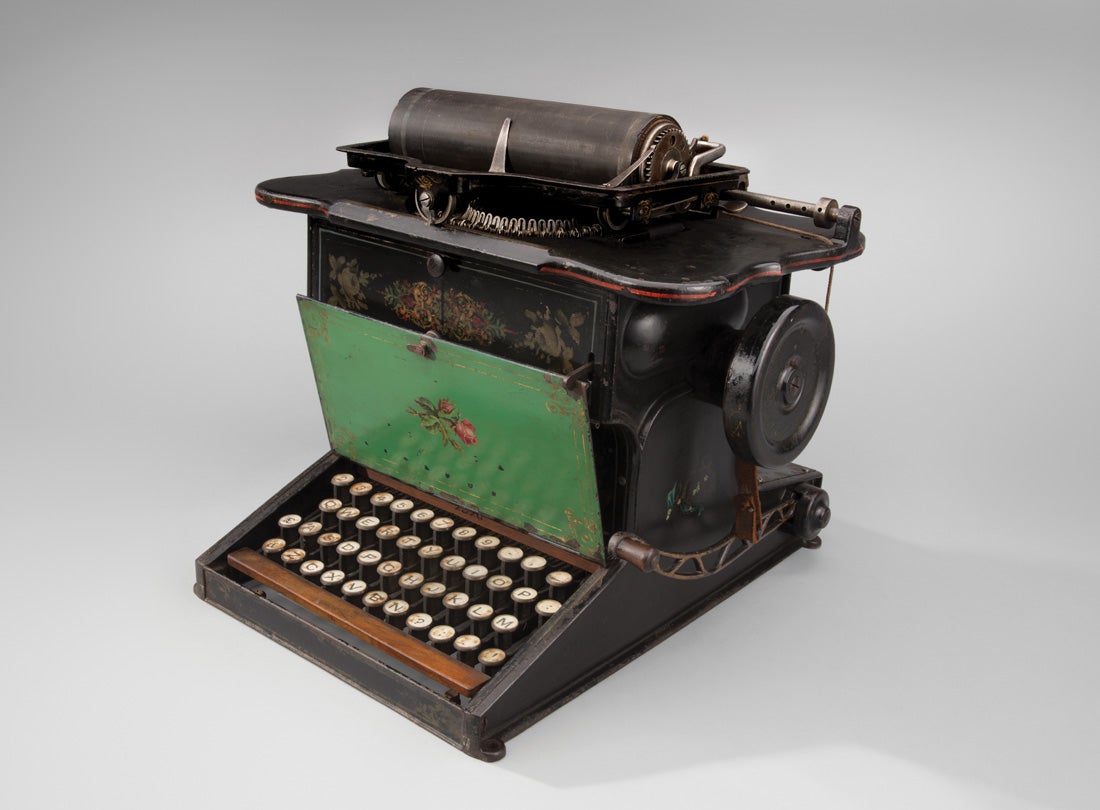








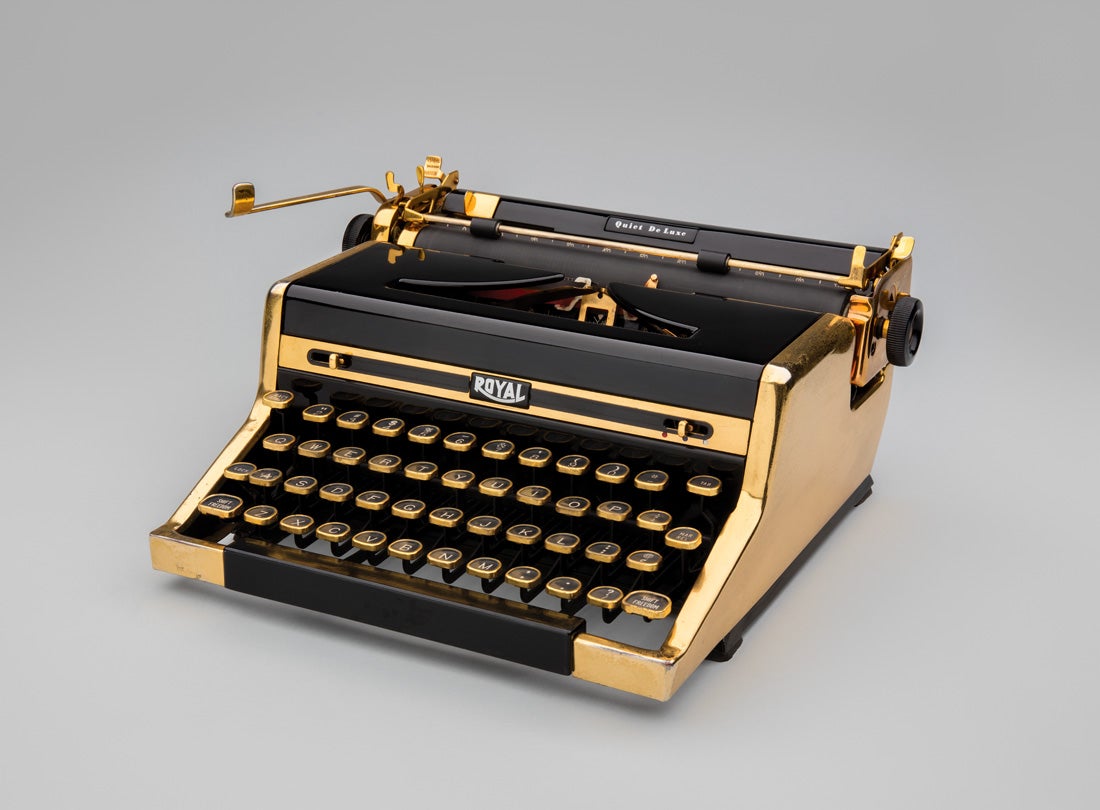

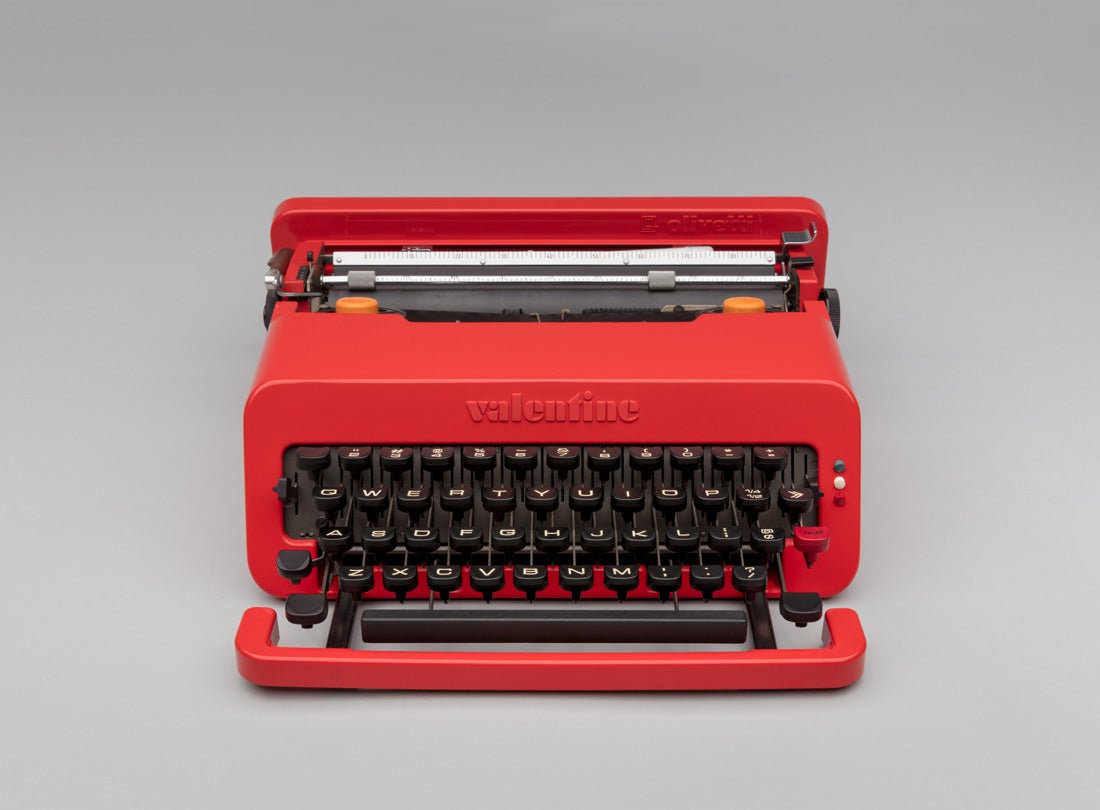
Sholes & Glidden Type Writer 1875
E. Remington & Sons
Ilion, New York
anonymous lender
L2017.0607.001
Sholes & Glidden Type Writer
The Sholes & Glidden Type Writer ushered in a new era of communication technology. Invented by Christopher Latham Sholes (1819–90) with assistance from Samuel Soulé (1830–75) and Carlos Glidden (1834–77) in Milwaukee, Wisconsin, it was the first commercially produced typewriter with hinged type-bars and a four-row keyboard. In 1873, the Type Writer introduced “QWERTY,” a keyboard layout named for the first six letters at the top-left row of letter keys. Organized to prevent type-bars from clashing and jamming prototype machines, QWERTY was mechanically suited to the Sholes & Glidden and not necessarily designed for efficient typing. Contemporary computers, tablets, and smart phones share the QWERTY keyboard layout.
Crandall New Model c. 1890
Crandall Machine Company
Groton, New York
Courtesy of Steve Soboroff
L2017.0606.001
Type-sleeves
A defining advantage of the rotating type mechanism was its adaptability. In contrast to the array of hinged type-bars found on more conventional machines, a type-shuttle or type-sleeve could be changed to convert from one language to another. Hundreds of options were available, from foreign languages to scientific applications. Patented in 1879, the Crandall was the first production typewriter that printed via a type-sleeve. Ornately decorated with mother-of-pearl inlays, it featured six rings of type molded around a cylinder that rotated into place and swung directly onto the paper. Much like the IBM Selectric of the 1960s, type-sleeves for the Crandall were available in a variety of fonts.
Remington Standard No. 12 1927
Remington Typewriter Company
Ilion, New York
Type-O-Meter conversion c. 1938
General Coin Automatic Co.
San Francisco
Collection of Joe Welch American Antique Museum
L2017.0608.001
Industry
Advances in industry and business made the typewriter both possible and indispensable. Early typewriter factories combined recently developed processes such as steel stamping and zinc plating with aluminum, cast iron, vulcanite, and other new materials into their assembly lines. At the same time, typewriters created massive amounts of paperwork to support increased organization and communication in manufacturing and business. By the 1930s, the typewriter was such a commercial success that even coin-operated conversions were offered.
Hammond 1b c. 1890
The Hammond Typewriter Company
New York
anonymous lender
L2017.0607.005a
Type-shuttles
During the 1880s, a multitude of patents for new typewriter designs were introduced. One of the most innovative was invented by James B. Hammond (1839–1913), a Civil War correspondent who became frustrated as news press staff misinterpreted and incorrectly printed his handwritten reports. While too late for wartime use, Hammond’s typewriter was one of the most enduring non-type-bar designs. Patented in 1880, it featured a curved, piano-style keyboard and printed via a type-shuttle. On a Hammond, when a key is pressed the type mechanism rotates into place and is struck by a hammer, making the impression between paper and ink ribbon.
Odell Type Writer No. 4 c. 1900 | Victor Type Writer 1889–92 |
Index TypewritersIn the 1890s, the cost of a new, full-size typewriter was more than the average American earned in one month. Index typewriters were a simpler and more affordable alternative. Available at a fraction of the price and manufactured in a variety of designs, they were the earliest portable writing machines. The Odell was a popular, linear-index typewriter that printed upper-and lower-case characters through a sliding index coupled to shift and selector keys. The innovative wheel-index Victor typewriter printed from type attached to the ends of strips arranged in a daisy-wheel pattern, much like the IBM Wheelwriter a century later.
Japanese Typewriter 1940
Nippon Typewriter Co., Ltd.
Tokyo & Osaka, Japan
Courtesy of Thomas S. Mullaney
L2017.0605.001.01
The Japanese Typewriter
Kanji, or Japanese character writing, is based on Chinese script and shares many meanings and definitions. Officially published in the Jōyō Kanji, around 2,000 Chinese-based characters are listed for use in conjunction with a distinct, Japanese kana alphabet. In 1915, Japanese printer and inventor Kyota Sugimoto (1882–1972) patented a typewriter that printed in both Chinese and Japanese. Manufactured by the Nippon Typewriter Company, the machine featured a large, sliding tray with room for 2,450 individual type-slugs. A moving carriage assembly mounted over the tray contained the typing mechanism. To operate, the typist positioned the tray and carriage along an x–y axis to select a type-slug, and depressed a button to retrieve, ink, and print.
Blickensderfer No. 5 1902 | Corona No. 3 Special 1929 |
Early Portables
George C. Blickensderfer (1850–1917) introduced the first portable typewriter with a full keyboard in 1893. Designed around an easily changeable type-wheel that rotated and struck the platen to print, the Blickensderfer was quite popular and could accommodate over one-hundred foreign language and scientific applications through a variety of type-wheels. The next revolutionary portable was the Corona 3, first patented as the Standard Folding Typewriter in 1904. This front-stroke machine featured a three-row, double-shift keyboard with a carriage that folded forward for maximum portability.
Underwood Standard Portable Typewriter with hand-lettered case 1926
previously owned by Orson Welles (1915–85)
Underwood Typewriter Company
New York
Courtesy of Steve Soboroff
L2017.0606.002.01–.02
Orson Welles
On October 30, 1938, radio listeners across America were driven into a state of panic. That night, the Mercury Theater of the Air presented “War of the Worlds,” a radio show by theater actor Orson Welles (1915–85). An adaptation of the science fiction novel by H.G. Wells (1866–1946), it detailed scenes of a Martian invasion that thousands of listeners mistook for the real thing. Seven years before the broadcast, Welles, at age sixteen, had travelled to Europe and found work at the Gate Theater in Dublin, Ireland, after convincing the theater manager he was a vacationing member of the Theater Guild. Welles returned to the States for a stint on Broadway, and worked for supplemental income in radio as the voice of “The Shadow.” His most famous project was Citizen Kane, a controversial, yet critically acclaimed motion picture based loosely on the life of newspaper baron William Randolph Hearst (1863–1951).
Corona Standard with Animal Keyboard 1936
L.C. Smith & Corona Typewriters, Inc.
Groton, New York
anonymous lender
L2017.0607.017a
Corona Standard with Animal Keyboard
In the mid-1930s, L.C. Smith & Corona offered an “Animal Keyboard” option on their popular Silent, Sterling, and Standard portable typewriters. Marketed to teach children to type, these rare, Depression-era machines included a set of finger rings that corresponded with illustrated animals on the keys. Keyboard columns were color-coordinated to the finger rings and featured animals such as bluebirds, bear cubs, kittens, and bunny rabbits. An illustrated play book was included, and color-coordinated keyboards were also offered without animal keys as instructional devices for older children.
Royal Quiet De Luxe 1949
Royal Typewriter Company, Inc.
Hartford, Connecticut
Courtesy of California Typewriter
L2017.0604.001.01–.02
Modern Portables
After the Second World War, typewriter manufacturers that had converted to arms production returned to the typewriter business. Much like the automobile industry, most “new” models were mechanically similar, and at times identical, to pre-war machines—re-introduced with catchy names in updated bodies, colors, and trim packages. Based on their first portable of 1926, post-war Royals added trademark features from standard Royal desktop machines such as “Touch Control” to adjust key sensitivity, and “Magic Margin” to automatically control page margins. With a restyled case by industrial designer Henry Dreyfuss (1904–72), the Quiet De Luxe was offered in an array of bright, mid-century colors, including a custom-order, gold-plated option also given as a prize for student writing contests.
Olympia SM7 1962
Olympia Werke AG
Wilhelmshaven, West Germany
Courtesy of Nick Tauriainen
L2017.0612.004.01
European Portables
European typewriter companies also ramped up production in the late 1940s. Some of the finest machines were made in West Germany by Olympia, who first manufactured four-bank portables in the 1930s. With the partition of Germany after the Second World War, Olympia relocated from Erfurt in Soviet-controlled, East Germany to Wilhelmshaven in the Western Zone and introduced the SM series of portables. Known for their sharp and snappy typing action, Olympia’s SM series were popular with students and literary writers worldwide.
Olivetti Valentine 1969
Ing. C. Olivetti & Co., SpA
Barcelona, Spain
Collection of Computer History Museum
102628789
L2017.0603.001a
Olivetti Design
Founded in 1908 by Camillo Olivetti (1868–1943) and succeeded by his son Adriano Olivetti (1901–60) thirty years later, Ing. C. Olivetti & Co. is associated with design more than any other typewriter company. Within a framework termed the “Olivetti style,” good design was central to all levels of production and advertising, and even extended to the factory floor and lifestyle of its workers. The Valentine is perhaps the most iconic Olivetti typewriter, envisioned by designer Ettore Sottsass (1917–2007) as an inexpensive and simple-yet-stylish portable. Based mechanically on the mid-1960s Lettera 32, the Valentine came in bright, pop-art colors and included an ABS plastic case that doubled as a waste-paper bin.
